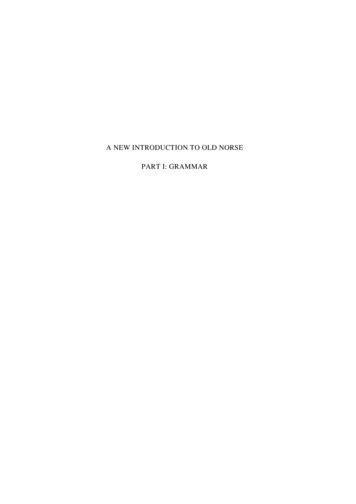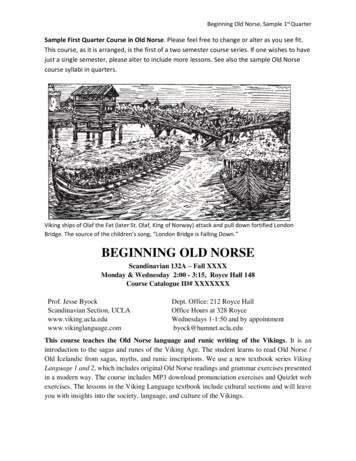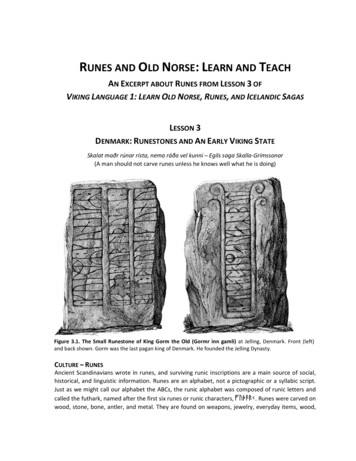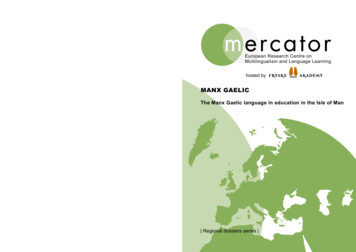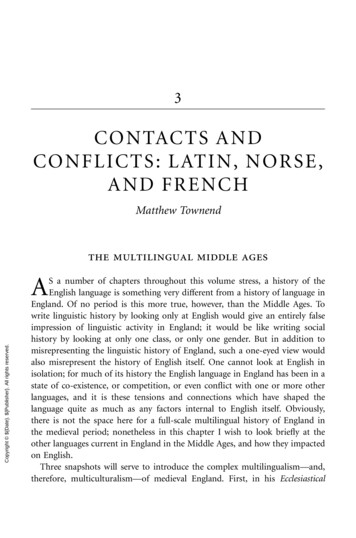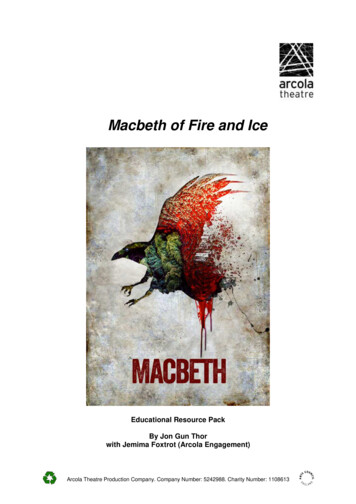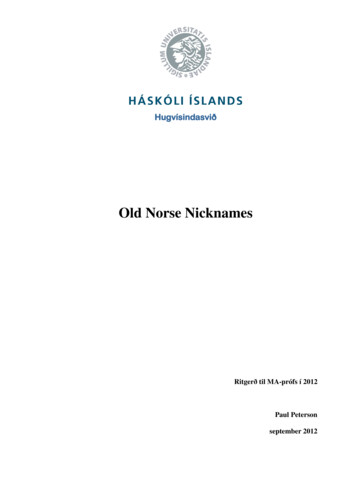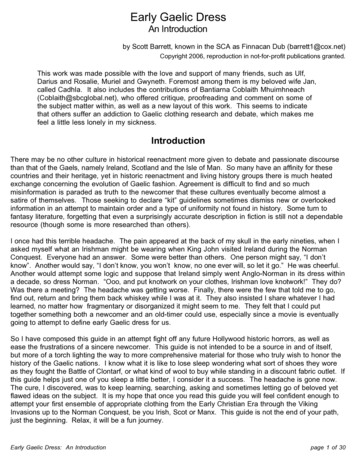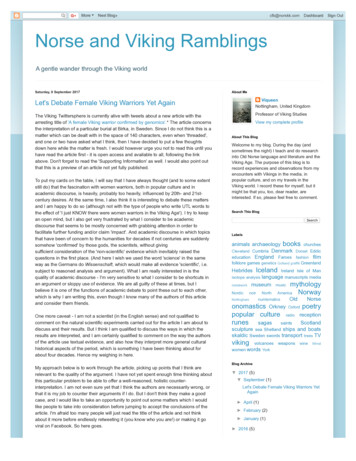
Transcription
MoreNext Blog»cfb@norskk.comDashboardNorse and Viking RamblingsA gentle wander through the Viking worldSaturday, 9 September 2017About MeLet's Debate Female Viking Warriors Yet AgainViqueenNottingham, United KingdomThe Viking Twittersphere is currently alive with tweets about a new article with thearresting title of 'A female Viking warrior confirmed by genomics'.* The article concernsthe interpretation of a particular burial at Birka, in Sweden. Since I do not think this is amatter which can be dealt with in the space of 140 characters, even when 'threaded',and one or two have asked what I think, then I have decided to put a few thoughtsdown here while the matter is fresh. I would however urge you not to read this until youhave read the article first - it is open access and available to all, following the linkabove. Don't forget to read the 'Supporting Information' as well. I would also point outthat this is a preview of an article not yet fully published.Professor of Viking StudiesTo put my cards on the table, I will say that I have always thought (and to some extentstill do) that the fascination with women warriors, both in popular culture and inacademic discourse, is heavily, probably too heavily, influenced by 20th- and 21stcentury desires. At the same time, I also think it is interesting to debate these mattersand I am happy to do so (although not with the type of people who write UTL words tothe effect of 'I just KNOW there were women warriors in the Viking Age'). I try to keepan open mind, but I also get very frustrated by what I consider to be academicdiscourse that seems to be mostly concerned with grabbing attention in order tofacilitate further funding and/or claim 'impact'. And academic discourse in which topicsthat have been of concern to the humanities for decades if not centuries are suddenlysomehow 'confirmed' by those gods, the scientists, without givingsufficient consideration of the 'non-scientific' evidence which inevitably raised thequestions in the first place. (And here I wish we used the word 'science' in the sameway as the Germans do Wissenschaft, which would make all evidence 'scientific', i.e.subject to reasoned analysis and argument). What I am really interested in is thequality of academic discourse - I'm very sensitive to what I consider to be shortcuts inan argument or sloppy use of evidence. We are all guilty of these at times, but Ibelieve it is one of the functions of academic debate to point these out to each other,which is why I am writing this, even though I know many of the authors of this articleand consider them friends.One more caveat - I am not a scientist (in the English sense) and not qualified tocomment on the natural scientific experiments carried out for the article I am about todiscuss and their results. But I think I am qualified to discuss the ways in which theresults are interpreted, and I am certainly qualified to comment on the way the authorsof the article use textual evidence, and also how they interpret more general culturalhistorical aspects of the period, which is something I have been thinking about forabout four decades. Hence my weighing in here.My approach below is to work through the article, picking up points that I think arerelevant to the quality of the argument. I have not yet spent enough time thinking aboutthis particular problem to be able to offer a well-reasoned, holistic counterinterpretation. I am not even sure yet that I think the authors are necessarily wrong, orthat it is my job to counter their arguments if I do. But I don't think they make a goodcase, and I would like to take an opportunity to point out some matters which I wouldlike people to take into consideration before jumping to accept the conclusions of thearticle. I'm afraid too many people will just read the title of the article and not thinkabout it more before endlessly retweeting it (you know who you are!) or making it goviral on Facebook. So here goes.View my complete profileAbout This BlogWelcome to my blog. During the day (andsometimes the night) I teach and do researchinto Old Norse language and literature and theViking Age. The purpose of this blog is torecord experiences and observations from myencounters with Vikings in the media, inpopular culture, and on my travels in theViking world. I record these for myself, but itmight be that you, too, dear reader, areinterested. If so, please feel free to comment.Search This BlogSearchLabelsanimals archaeology books churchesCleveland Cumbria Denmark Dorset Eddiceducation England Faroes fashion filmfolklore games geneticsHebridesGotland graffitiGreenlandIcelandIreland Isle of Manisotope analysis language manuscripts logyAmerica NorwaymusicnumismaticsOldNorseonomastics Orkney Oxford poetrypopular culture radio receptionrunes sagas saints Scotlandsculpture sea Shetland ships and boatsskaldic Sweden swords transport trees TVvikingvolcanoeswomen words YorkweaponswineWirralBlog Archive 2017 (5) September (1)Let's Debate Female Viking Warriors YetAgain April (1) February (2) January (1) 2016 (5)Sign Out
(1) I note that while the article has ten authors, they have chosen not to involve anyspecialist in language or texts, in spite of the fact that the article begins with referenceto early medieval 'narratives about fierce female Vikings fighting alongside men', andconcludes with a quotation from an Eddic poem in translation. The impression given isthat the authors consider that no special expertise is required to handle this kind ofevidence unlike bones, or DNA, or archaeological finds. The authors might argue thatthey cite people who do have such expertise, including myself. I would just point outthat their primary reference to my work is to a semi-popular book published 26 yearsago. (See also point 6., below). I would have thought they could have made the slighteffort required to read what I wrote on the subject of women warriors in a recentmonograph (The Viking Diaspora 2015, pp. 104-7), a less popular and moreconsidered work. There (and elsewhere when I have written about such things) I do tryto show that women warriors and/or Valkyries and/or shield maidens (they are all oftenmixed up) are not just 'mythological phenomena' as stated by the authors, but relate toa whole complex of ideas that pervade literature, mythology and ideology, withoutnecessarily providing any direct evidence for women warriors in 'real life', which is whatI take the current authors to be interested in. I do wish the authors would engage withthese more subtle and complex interpretations, rather than just unthinkingly using textsboth as the starting and the finishing point of their argument, without any indication ofwhat narratives they have in mind, or even what kind, or any explanation of why aparticular quotation might be relevant. An example of their sloppy thinking is when theyclaim that 'the material and historical records' both suggest that 'the male sex has beenassociated with the gender of a warrior identity' (a statement I think I understand, but itsounds awkward). This is to elide the nature of two very different types of evidence anddoes, in my view, a disservice to what they call 'historical records' (which may or maynot be the same as the 'narratives' or 'mythological phenomena' referred to earlier).Needless to say, they do not specify what 'historical records' suggest this (or indeedwhat 'material records' do the same, whatever they are).(2) Several times in the article the authors refer to an earlier article by the secondnamed author (Kjellström 2016)** which appears to be of great importance to theirargument because in it she apparently provided 'a full osteological and contextualanalysis', 'age and sex estimation results' and 'sex identification and a propercontextualisation' for the burial in question. The scientific analyses of the current articleapparently arose out of a desire to confirm (as the title of the article suggests) theseearlier results by scientific means. Having followed up the article in question, I can findnothing in it which explains why this osteological and contextual analysis suggests thedeceased was a female - it's a rather general article summarising the author'sosteological research on a large body of material which may well have included burialBj 581, but does not say much about this particular burial. Without specifying its details,the earlier article does refer to a 'chamber grave furnished with fine armour andsacrificed horses' for which 'three different osteological examinations all found that theindividual was a woman'. I suppose this is the grave under consideration in the mostrecent article, but interestingly, the author concludes that 'Whether these are not thecorrect bones for this grave or whether it opens up reinterpretations of weapon gravesin Birka, it is too early to say' (the article was originally presented at a conference in2013, not 2014 as suggested in the current article). This is because of problems arisingfrom the fact that the graves were mainly excavated in the 19th century and there hasbeen a certain amount of confusion regarding where various bags of bones came from.Extraordinarily enough, this is not even mentioned in the current article. It is admittedlycovered, though fairly briefly, in the 'Supporting Information' to the current article, but Ido think this element of possible doubt is crucial enough to have been mentioned in themain article, which is what most people will read - many will not even be aware of thestatus or significance of the 'Supporting Information', which contains both tablesshowing the scientific results and some discursive comments about sex and genderidentities in Viking Age graves.(3) Having concluded, to their own satisfaction, that the deceased in Bj 581 was indeeda female warrior, the authors go on to conclude, with very little discussion orjustification, that she was 'a high-ranking officer', based apparently on the fact that theburial contained 'a full set of gaming pieces' which apparently 'indicates knowledge oftactics and strategy'. Another factor which may have led them to this conclusion,though it is not stated explicitly, is the fact that they determined that the individual was'at least above 30 years of age'. By the end of the article, 'the individual in grave Bj 581is the first confirmed female high-ranking warrior', because 'the exclusive grave goodsand two horses are worthy of an individual with responsibilities concerning strategy and 2015 (7) 2014 (9) 2013 (15) 2012 (18) 2011 (35) 2010 (36) 2009 (16) 2008 (31)Subscribe ToPostsAll CommentsFollowersMy Blog ListFollowers (135) Nextphoto hebridesfishing net, Elgol1 day agoVikingArchaeologyBlogBreaking News: AViking SwordFound at HighAltitude1 day agoAardvarchaeologyFollowTotal Pageviews251,202LinksAcademia.eduCentre for NordicStudiesCentre for theStudy of theViking Age,University ofNottinghamCentre for theStudy of theViking Age,University ofNottingham, onTwitterChristina Lee onTwitterFair IsleJudith Jesch onTwitterOrkneyjarUnst Bus ShelterViking Society forNorthernResearchA Female VikingWarrior Interred atBirka3 days agoMedievalHistoriesThe Lombards – APeople who madeHistory1 week agoGamla Uppsala- a mythicalcentreThe burnt timbersof the hallappears.1 week agoSoul ChaserBecky BookwormBook Review From Asgard toValhalla:RemarkableHistory of NorseMyths by HeatherO'Donoghue1 week agoOrkney Archive- get dustyThe OrkneyHurricane1 week ago
battle tactics'. All this seems to me to move rather quickly from evidence to speculationwhich is presented as fact.(4) The authors also note that there were 'No pathological or traumatic injuries'observed on the skeleton. They point out that 'weapon related wounds . are notcommon in the inhumation burials at Birka' and elsewhere, so apparently the 'warriors'of these graves were either so good that they were never injured, or perhaps theyweren't really 'warriors' at all. According to the authors 'our results caution againstsweeping interpretations based on archaeological contexts and preconceptions' - theydo not seem to recognise that if they take this principle to its logical conclusion, theinterpretation of this and many other graves as 'warrior' graves is thereby called intoquestion. They can't have their cake and eat it too. They also say nothing aboutwhether there was any indication on the bones of the kinds of activities one mightexpect a warrior to have engaged in, as strenuous physical activity might be expectedto have left some traces, particularly if they were good enough to avoid injury tothemselves.(5) Although the authors point out that 'previous arguments have . neglectedintersectional perspectives' they do not really pursue alternative explanations regardingBj 581 either. Was it possible, for example, for a biological woman to have been buriedwith a full 'warrior' accoutrement, even if she had not been a warrior in life? After all,archaeologists are always cautioning us that 'the dead don't bury themselves' and theyoften seem not to like interpretations in which the deceased's grave goods are taken asrepresenting their roles in life. But such perspectives do not seem to be applied here they want the woman to be a warrior, so the scientific analysis makes her a woman andher 'archaeological context' makes her a warrior. No doubt other explanations arepossible, still assuming that the bones have been correctly assigned to the gravegoods, but discussion of such alternatives would rather detract from that arresting title,and would probably have ruled out publication in the American Journal of PhysicalAnthropology. The authors might have been better advised to keep this article to thepurely scientific data, and leave the interpretation of it to other contexts which mighthave given them more space to reason more carefully.(6) Finally, a bit of a rant against the prevalence of short name date references inscientific and archaeological articles. Reference to an article in a scientific journal inthis way is OK when the article is only a few pages long, as they often are. But referringto a 230 -page book as Name Date is cheating. The interested reader who may wantto follow up the point being 'supported' by such a reference is faced with havingpossibly to read the whole book, or to work out from the index which of several possiblesections of the book contain the information on which the referring authors rely. Andone does sometimes get the impression that authors using such a reference systemhave not really read the work in question, at least not carefully or thoughtfully.These are some of my caveats which I would dearly love people to take into accountbefore tweeting all over the world about women warriors in the Viking Age. It's too easyto take the title of an article at face value and send it round the Twittersphere withoutfurther thought. I do know I'm banging my head against a brick wall, since I haveblogged, spoken and written about these matters before and have come to realisethat the emotional lure of the woman warrior, especially in the Viking Age, is too strongfor reasoned argument.Nevertheless, I am still happy to engage in this debate. And just in case there is anydoubt, although this blog is ostensibly anonymous, my name is Judith Jesch and I amhappy to acknowledge what I have written above - with this kind of direct critique of anarticle by people I know well, anonymity would be completely unethical. I did considersending this piece to https://theconversation.com/uk so as not to be anonymous, butprevious experience with them suggests that long and complex pieces don't really workthere. Taking complex research to the general public inevitably involves a loss ofcomplexity. But it shouldn't do in an academic journal, and it is in the end the academicarguments I am most concerned with. I do also like trying to explain complex academicarguments to those who don't normally engage with them, but that's another story.* Hedenstierna-Jonson C, Kjellström A, Zachrisson T, et al. A female Viking warriorconfirmed by genomics. Am J Phys Anthropol. eologi i nordTil Romaborg for1000 år siden2 weeks agoFair IsleIt's Time to SayGoodbye to thePuffins4 weeks agoThe Troublewith Old BoatsFaering under Sail4 weeks agoVikingSpecialist atLargeThe VikingColoring BookProject Fall 2017Catalogue5 weeks agoBerserkjablogg#Viking is not averb!1 month agoBringingVikings back tothe EastMidlandsViking and AngloSaxon StoneSculpture inNottinghamshireand Derbyshire1 month agoMedievalMidlands Newsand events frommedievalists inthe Midlands,UKReligion andConflict in theMedieval andEarly ModernPeriods1 month agoViking MetalDid Viking womensettle in England?1 month agoVikings, Books,etc.Local Flavor:Current NordicSpeculative FictionOnline2 months agoAnglo-Saxon,Norse & CelticBook of Uí MhaineConference, 20174 months ago
**Kjellström A, (2016) People in transition: Life in the Malaren Vallye from anOsteological Perspectve. In V. Turner (Ed.), Shetland and the Viking World. Papersfrom the Proceedings of the 17th Viking Congress 2013 (pp. 197-202). Lerwick:Shetland Amenity Trust.Posted by Viqueen at 17:1727 comments:Links to this postWednesday, 12 April 2017Writing the Ice-Bear III promised to return to the topic of polar bears andmy memory was jogged by the news, a few daysago, that a polar bear was shot in Newfoundlandafter being deemed 'a public safety risk'. In times ofecological crisis these magnificent animals aredriven towards human habitation in search of foodand it usually does not end well for them, as aPolar bear in the Svalbard Museum,hungry bear is a real danger to humans and it is notLongyearbyenalways easy or even possible to tranquilise andremove them. These latter options were not really available to people in former timesand when polar bears drifted over to Iceland, it could go either way. The Icelandicannals record that, in 1321 a hvítabjörn came on the ice to Strandir in the north-west ofIceland, killing eight people and causing much destruction before he was finally killedon Straumnes. Another annal records that, in 1275, no less than 27 polar bears werekilled in Iceland. Presumably, this was not all on one occasion (the bears tend to bequite solitary), but a result of the fact that, in that winter, kringdi hafíss nær um alltÍsland 'sea-ice encircled almost all of Iceland'. That this was an unusual event issuggested by the law in the Christian Laws Section of Grágás which stipulates that,while people are not supposed to hunt and fish on holy days, they can go out to catch apolar pear if one turns up. Another exception to usual practice in this law is that thebear belongs to 'whoever gives it a death wound', rather than whoever owns the landon which it is killed, which is otherwise when, for example, whales are stranded. Theowner was then left with a nice pelt, for it is hard to imagine anyone wanting to eat apolar bear (though see below).Curiously it seems that people did have tame polarbears, most likely caught as cubs (either inGreenland, or having sailed to Iceland on an ice floe)since taming an adult bear is surely animpossibility. Grágás stipulates that a tame polarbear is to be treated like a dog, namely that its ownerMural in Thon Hotel Polar, Tromsøneeds to pay for any damage it does. While such abear has no immunity if it harms people, if it is itselfharmed, then the person who harmed it pays a fine and compensation for the damageto the owner.Humans' curious love-hate relationship with bears of all kinds issuggested by the popularity of the name Bjorn, or names with björn as the second element, then as now, and many stories turnon the human-like qualities of bears. There is a curious reciprocityin a story recorded in Landnámabók (the Icelandic Book ofSettlements) about a certain Arngeirr, a settler in the north-east ofIceland and his son Þorgils. When they didn't return from lookingfor their livestock in a snow-storm, the younger son Oddr goes tosearch for them and finds them 'lying as food' for a polar bear, asSturlubók puts it (Hauksbók at this point has a vivid image of theAvailable from thebear sucking the blood out of them). Oddr kills the bear and isworld's mostsaid to have eaten it all. In fact, the saying was that he avengednortherly chocolatier.his father in killing the bear, and his brother in eating it. But as aresult he becomes evil and unruly, and shape-shifts at night so that the neighbourswanted to stone him to death for being a sorcerer. It's hard to imagine that eating awhole polar bear was very tasty so, while doing this was quite heroic, it does seem toPassages fromTiree6 months agoRunes,Monuments andMemorialCarvingsSculptured stonesas transgressiveobjects. Call forpapers EAA 2017.7 months agoCarolyneLarrington'sWebsite78 Degrees North7 months agoA Corner ofTenth-CenturyEuropeDuncan Probert8 months agoOrkneyjar OrkneyArchaeologyNewsSmerquoyexcavation update– August 16, 20161 year agoThe World-TreeProject AnInteractiveDigital Archivefor the Teachingand Study ofthe VikingsIASIL 2016 –Digital Ireland:Transforming themedieval past1 year agoThe ShetlandBoat: History;Folklore &Construction. Progress in theacademicresearch of theShetland boat.The first Shetlandboat week Mon8th Aug – Sun14th Aug1 year agoNorse in theNorth OldNorse andViking Studiesat Durham,Leeds and York2016 Conference– open forsubmissions1 year ago
Runer ogmønterhave been in general quite a bad idea.Another interesting aspect of polar bears in Old Norse texts is how frequently they turnup in dreams. But that is a matter I will leave to another blog.Posted by Viqueen at 15:43No comments:Links to this postLabels: animals, Greenland, Iceland, sagasSunday, 19 February 2017One Day Without Vikings?I am a serial migrant. Twice in my life I have madethe move to a new country (not including shorterstays of a few years in yet other countries), in bothcases becoming a citizen and intending to stay. Itlooks like the second one is my forever home - Ihave now been a UK citizen for a quarter of acentury and have no plans to move. In my firstadopted country, I was schooled from a young age inthe slogan 'No taxation without representation!' andthat motivated me to become a citizen in my second adopted country - I was by thenpaying taxes and wanted to take a full part in the life of the country that was now home.I therefore naturally have an interest in tomorrow's National Day of Action on Feb 20thto Celebrate the Contributions of Migrants to the UK, or @1daywithoutus /#1daywithoutus.But I also have a professional interest in the contributions of migrants, at least those inthe past. If we take the long view historically, then of course everyone in these islandsis a migrant, at least since the last Ice Age covered them, and I do think everyoneshould reflect on that simple fact, as well as on the contributions of migrants,whether over the last 10,000 years, or the last 10 years. Among the many identifiablegroups who have made an enormous contribution to the life of these islands are thepeople of Scandinavian origin we call 'Vikings', who settled here between the ninth andeleventh centuries. To some they are best known for raiding and pillaging, as if theywere the only people in the Early Middle Ages who did these things (they weren't). Butmost people also know that they moved into large swathes of eastern and northernEngland, into large parts of Scotland, and that they founded towns and othersettlements in Ireland. These immigrants were not raiders and warriors, but farmersand traders, and families with women and children as well as men.What was their contribution? Well, by farming the land and engaging in local, nationaland international trade, they made the contribution to the economy that we normallyexpect of immigrants (and the indigenous inhabitants, too?), and they paid their taxes.They came in sufficient numbers for their language and culture to become an indeliblepart of the language and culture of these islands. Even the first word in the previoussentence comes from Old Norse, this infiltration of some of the most basic features ofthe language (in this case a pronoun) being unprecedented in any other migration otherthan that of the Anglo-Saxons before them. At the other extreme, the English word 'law'comes from Old Norse - the Vikings gave us the very foundation of this nation'sexistence. It is not possible to have one day without Vikings, even now in the twentyfirst century.Words and place-names of Old Norse origin are around you, everywhere, everyday.You can find out more about the Vikings' contribution to the English language throughthe Gersum project. You can learn more about English place-names of Old Norse originat the Key to English Place-Names. You can also find out about physical objects fromthe Viking period through for example the Portable Antiquities Scheme and the Corpusof Anglo-Saxon Stone Sculpture. And this year is the Year of the Viking, when you cancome to Nottingham for a special British Museum / York Museums Trust exhibitionopening in November. As well as the exhibition, there will be a lot of different eventsdedicated to explaining the contributions of those migrants, the Vikings, branded as'Bringing the Vikings Back to the East Midlands'. These will be advertised on thewebsite of the Centre for the Study of the Viking Age at the University of Nottingham,so keep your eye out there! Or just follow Viking Midlands on Twitter - the project isDurup-stenen erIKKE stjålet1 year agoLandscapes ofthe NorthThrough the MistyMountains2 years agoThe ModernHistorian, theCanadianMedievalist, andother suchOxymorons50th AnnualInternationalCongress ofMedieval Studies2 years agoHelen'sWonderingWanderingsMoving.2 years agoLanguages,Myths andFinds Exploring Norseand Vikingheritage incommunitiesaround Britainand Ireland2014 in review2 years agoThe OrkneyProjectBooklets on VikingHeritage2 years agoBradfordVikingsBradford Vikingsand the maraudinghordes in Orkney3 years agoVikingMindsladyrosenred: :)4 years agoThe SagaSteads ofIceland: A 21stCenturyPilgrimageIn Our (Saga)Time4 years ago
currently in its infancy but more information will follow soon.In the meantime, remember the migrants, not just tomorrow, but every day!Posted by Viqueen at 20:29No comments:Links to this postLabels: England, Ireland, language, museum, Old Norse, onomastics, Scotland, vikingSunday, 5 February 2017Writing the Ice-Bear IMy excellent friend the Snow Queen (I call her thatfor reasons you may or may not be able to work out)has written about our arctic adventures, so I don'thave to. Thanks! But since the polar bear was sucha leitmotif of our travels, particularly in Svalbard, Ithought I'd follow up with a little footnote rounding upsome of the polar bears in Old Norse-Icelandicliterature. But just before that, if you think there issomething funny about the franked stamp to the left(a genuine one on a postcard that I sent), you'reright. There aren't 52 days in January. I'm assumingthat's a typo for 25 (the day after we left), but I'm wondering how it came about. Dothey still use hand stamps with those rotating numbers for setting up the date?Anyway, back to ice bears. Of course everyone's favourite and the best known exampleis from that staple of beginners' Old Norse courses, the Tale of Audun from the WestFjords, as it has most recently been translated. I don't want to spoil the story for thosewho have not read it yet - it's a short tale that will give you great pleasure and also foodfor thought! But basically it concerns a young Icelander who makes his way in the worldby working for a travelling merchant in Norway and Greenland. In Greenland he givesall he has for a bear. Then, through a really risky series of voyages, involvingtreacherous stewards, encounters and delicate negotiations with the kings of Norwayand Denmark, and a tough pilgrimage to Rome, he returns to Iceland a wealthy andrespected person. The bear disappears partway through the story and we never reallyfind out what happened to the creature. I guess its real role in the story isto illustrate both Audun's risk-taking and his cleverness. Having given all he had for abear, a bear from Greenland, and therefore a rarity and a 'treasure' (as the story callsit), it takes real guts and wits to transform that bear into a fortunate outcome forhimself, indeed an outcome that is not at all certain until the end. I haven't spoiled thestory for you because it's how he does it that is the real interest of the tale. Indeed, theAmerican professor of law William Ian Miller has written a whole book about theintricacies of this jewel of Old Icelandic narrative (though beware, students, there aretwo versions of the tale, with some interesting differences).Given the long sea-voyages involved, and the natureof polar bears, one has to assume that whenAudun first acquired it in Greenland, the bear was acub (compare the stuffed version we saw in themuseum, right). Audun was not himself a hunter, thestory makes clear that he paid for it. The story alsomakes clear that things got a bit tricky when hecouldn't afford to feed it any more, as it must havegrown faster than he anticipated and a hungry polarbear is a fearsome sight to behold.Tethered polar bear cub in SvalbardMuseum, LongyearbyenAudun's tale is set in the middle of the eleventh century. Giving polar bears to importantpeople seems to have been quite the fashion back in those days, though we're neverreally told what these VIPs did with them. Presumably, they died an early death, buttheir skins would still have made a nice decoration for the royal hall. Iceland's firstbishop, Ísleifr Gizurarson, took a hvítabjörn 'white bear' with him to the emperor
Heinrich III in Saxony on his inaugural voyage in around 1056, which did the trick asHeinrich gave him his protection for the rest o
Norse and Viking Ramblings Saturday, 9 September 2017 Let's Debate Female Viking Warriors Yet Again The Viking Twittersphere is currently alive with tweets about a new article with the arresting title of 'A female Viking warrior confirmed by genomics'.* The article concerns the i
